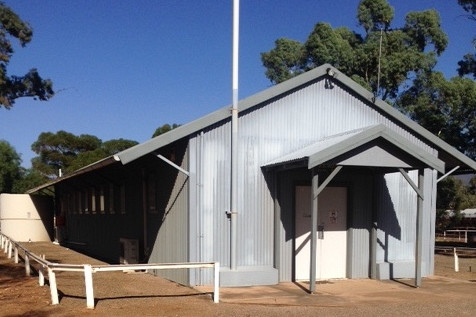
One of these 'tin sheds' was erected by the Department of Defence (Army) in February 1941 in the Quorn railway yard, behind the Cross of Sacrifice, to enable [an Army Service Corps Canteen, assisted by] the Country Women's Association (CWA) volunteers of Quorn, to provide meals day and night for military personnel and evacuees travelling on the Central Australia Railway corridor.
The volume of personnel travelling through was so great that the hut's function was superseded by a larger venue: the Memorial Hall at the town oval just beyond the Pinkerton Creek. [The CWA then also took on full responsibility for providing the meals.] Even here, a lean-to kitchen was added by the Army to improve throughput. In total around 350,000 meals were provided from these facilities during the war years—a sterling performance during those difficult times.
The Sidney Williams Company was responsible for the original and innovative design and the manufacture and distribution of these easily transported and erected all steel structures.
The company was earlier responsible for the design of the 'Comet' windmill which was used throughout the dry interiors and north of Australia. The windmills played a vital role in opening up the outback's grazing potential by tapping the artesian waters. The 'Comet' building (Sidney Williams hut) was then developed to support the growing grazing industry with similar success.
Their attributes were soon recognised by the Department of Defence. By 1942 Sidney Williams Co. was supplying up to forty huts per week in kit form to the department, whilst other manufacturers such as Cyclone and Gardener, provided a further dozen or so per week. Records are unclear but it is estimated that around 4,000 huts were erected in the north of Australia during World War II.
The cost of manufacture was reported to be about £8-8-0 and erection in the north was undertaken by both the military themselves and private contractors. With demobilisation of the forces after 1945 the Australian Disposal Commission undertook disposal by auction and tender. In the early 1950s a resold hut still commanded £7-10-0!
While these huts still remain in the Northern Territory in useful numbers even today, the hut at Quorn is probably one of the most southerly. As a testimony to the design it has been erected three times and dismantled twice in this town alone!
It should be made clear that these buildings are not Nissen huts. The Nissen hut was half-round in profile with roof and wall in one. The Nissen hut was less common in the far north.
After the war, the Sidney Williams hut in the Quorn railway yards was purchased by the CWA in 1946 and used as a rest room. In 1948 it was relocated to Seventh Street and continued to be used by the CWA.
Pichi Richi Railway Preservation Society Inc. purchased the Sidney Williams Hut from the CWA in 1992 and in 1995 relocated it back to the railway yards. Its original location in the railway yards was just slightly west of its new position.
References
Troppo Architects & National Trust of Australia (Northern Territory) & National Estate Grants Program (Australia) 1992, The 'Sidney Williams hut' : an information base on Sidney Williams & Co. & the Comet building, Troppo Architects, [Darwin].
McColl, Maureen 1993, A salute to Quorn, Maureen McColl, Quorn [S. Aust.], pp. 12-14 & p. 37.
Based on an article by Hayden Hart that was published in Pichi Richi Patter Volume 23 No. 1, Spring 1995. Edited and further details added by Andrew Thompson. Note that the CWA initially assisted the Army Service Corps Canteen in providing meals but later undertook full responsibility.
